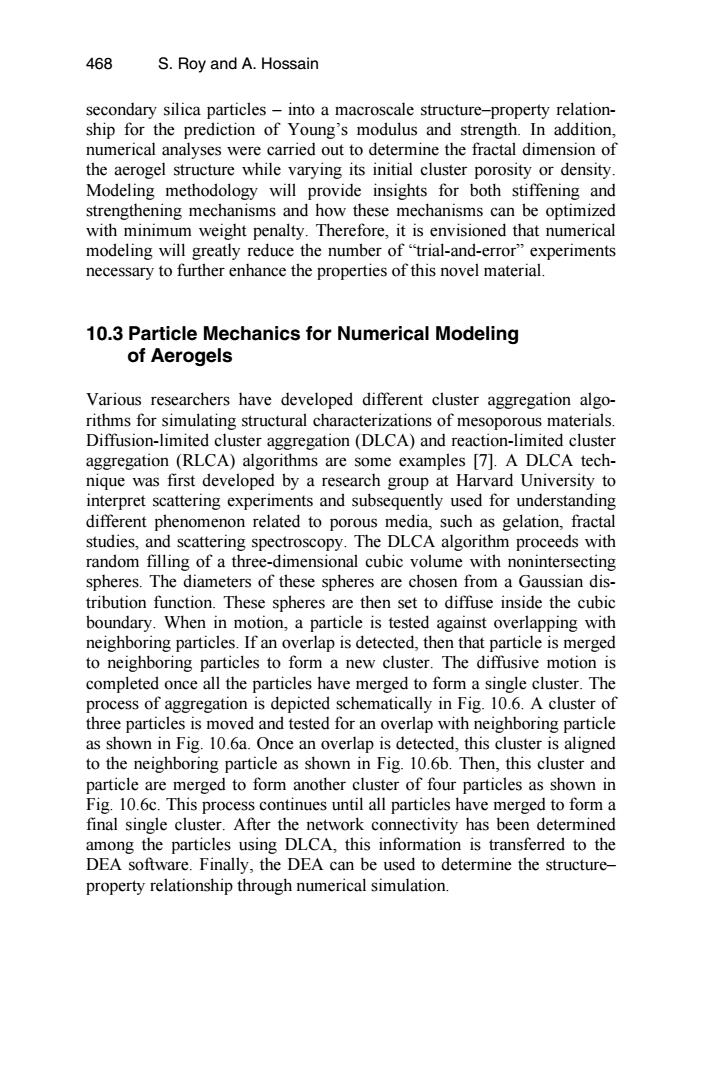正在加载图片...

468 S.Roy and A.Hossain secondary silica particles -into a macroscale structure-property relation- ship for the prediction of Young's modulus and strength.In addition, numerical analyses were carried out to determine the fractal dimension of the aerogel structure while varying its initial cluster porosity or density. Modeling methodology will provide insights for both stiffening and strengthening mechanisms and how these mechanisms can be optimized with minimum weight penalty.Therefore,it is envisioned that numerical modeling will greatly reduce the number of"trial-and-error"experiments necessary to further enhance the properties of this novel material. 10.3 Particle Mechanics for Numerical Modeling of Aerogels Various researchers have developed different cluster aggregation algo- rithms for simulating structural characterizations of mesoporous materials. Diffusion-limited cluster aggregation(DLCA)and reaction-limited cluster aggregation(RLCA)algorithms are some examples [7].A DLCA tech- nique was first developed by a research group at Harvard University to interpret scattering experiments and subsequently used for understanding different phenomenon related to porous media,such as gelation,fractal studies,and scattering spectroscopy.The DLCA algorithm proceeds with random filling of a three-dimensional cubic volume with nonintersecting spheres.The diameters of these spheres are chosen from a Gaussian dis- tribution function.These spheres are then set to diffuse inside the cubic boundary.When in motion,a particle is tested against overlapping with neighboring particles.If an overlap is detected,then that particle is merged to neighboring particles to form a new cluster.The diffusive motion is completed once all the particles have merged to form a single cluster.The process of aggregation is depicted schematically in Fig.10.6.A cluster of three particles is moved and tested for an overlap with neighboring particle as shown in Fig.10.6a.Once an overlap is detected,this cluster is aligned to the neighboring particle as shown in Fig.10.6b.Then,this cluster and particle are merged to form another cluster of four particles as shown in Fig.10.6c.This process continues until all particles have merged to form a final single cluster.After the network connectivity has been determined among the particles using DLCA,this information is transferred to the DEA software.Finally,the DEA can be used to determine the structure- property relationship through numerical simulationsecondary silica particles – into a macroscale structure–property relationship for the prediction of Young’s modulus and strength. In addition, numerical analyses were carried out to determine the fractal dimension of the aerogel structure while varying its initial cluster porosity or density. Modeling methodology will provide insights for both stiffening and strengthening mechanisms and how these mechanisms can be optimized with minimum weight penalty. Therefore, it is envisioned that numerical modeling will greatly reduce the number of “trial-and-error” experiments necessary to further enhance the properties of this novel material. 10.3 Particle Mechanics for Numerical Modeling of Aerogels Various researchers have developed different cluster aggregation algorithms for simulating structural characterizations of mesoporous materials. Diffusion-limited cluster aggregation (DLCA) and reaction-limited cluster aggregation (RLCA) algorithms are some examples [7]. A DLCA technique was first developed by a research group at Harvard University to interpret scattering experiments and subsequently used for understanding different phenomenon related to porous media, such as gelation, fractal studies, and scattering spectroscopy. The DLCA algorithm proceeds with random filling of a three-dimensional cubic volume with nonintersecting spheres. The diameters of these spheres are chosen from a Gaussian distribution function. These spheres are then set to diffuse inside the cubic boundary. When in motion, a particle is tested against overlapping with neighboring particles. If an overlap is detected, then that particle is merged to neighboring particles to form a new cluster. The diffusive motion is completed once all the particles have merged to form a single cluster. The process of aggregation is depicted schematically in Fig. 10.6. A cluster of three particles is moved and tested for an overlap with neighboring particle as shown in Fig. 10.6a. Once an overlap is detected, this cluster is aligned to the neighboring particle as shown in Fig. 10.6b. Then, this cluster and particle are merged to form another cluster of four particles as shown in Fig. 10.6c. This process continues until all particles have merged to form a final single cluster. After the network connectivity has been determined among the particles using DLCA, this information is transferred to the DEA software. Finally, the DEA can be used to determine the structure– property relationship through numerical simulation. 468 S. Roy and A. Hossain